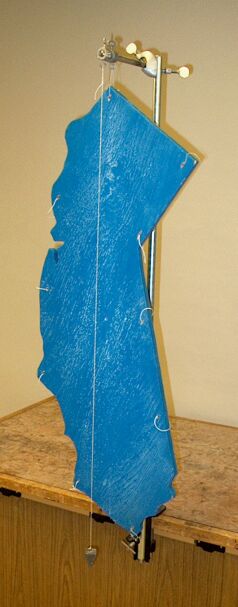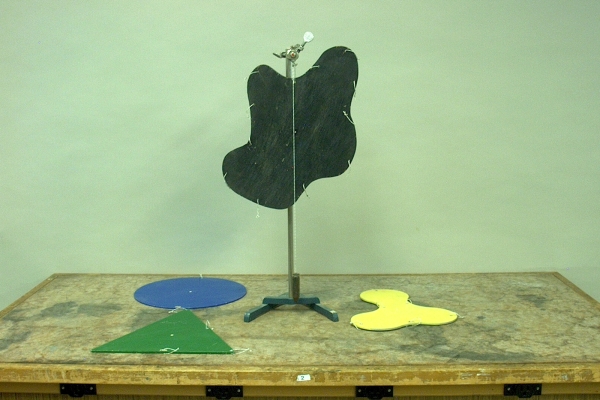
A video of this demonstration is available at this link.
A smaller version of this demonstration, shown below, is available for use at a remote location.
A board cut in the shape of California has string looped through holes at various points around its perimeter. Suspend the board from one of these loops. Draw a chalk line down the board along the line of the plumb bob string. If you do this for two suspension points, the point at which the two chalk lines intersect is the center of mass. You can do this for several different orientations to show that all the lines you make this way intersect at the center of mass, but that all you need to determine the location of the center of mass are two.
The center of mass of an object is the weighted mean displacement of all of its mass points from some reference point, usually the origin of the coordinate system in which the object sits. This is the sum of the products of all the mass points with their distances from the origin, divided by the total mass of the object (rcm = Σmiri/M). If we set the center of mass of the object at the origin, we find that this sum equals zero. This tells us that if we exert a force on the object at its center of mass, this results in no torque on the object, but if we apply a force to the object at any other point, we exert a torque on the object about its center of mass.
If the object is relatively small, and close to the earth, then gravity acts uniformly on the object. That is, if the object is of uniform density, gravity exerts the same downward force on all of its mass points, and the sum of all of these forces is equal to a single downward force, F = Mg, acting at the center of mass of the object. The torque due to each of these forces, about the center of mass of the object, is τ = miri × g, and the sum of the torques is τ = (Σmiri) × g. If we set the center of mass of the object at the origin, this sum equals zero. Thus if we apply a force at the center of mass, that is equal to and opposite that of gravity, we can support the object without exerting a torque on it about its center of mass. This point at which the resultant force of gravity acts is also called the center of gravity. If we take the force of gravity as being uniform over the entire object, then the center of gravity and the center of mass are the same point.
If an object has a regular shape, we may be able to calculate fairly easily from its density and its dimensions, where its center of mass lies. If, however, the object has some kind of irregular shape, this may be difficult or impossible to do. The properties of the center of mass of an object described above, however, give us an interesting way to find the center of mass of an irregularly-shaped object, such as the wooden board in the shape of the state of California of this demonstration, should we wish to do so.
If we suspend an object from any point other than the center of mass, we exert a torque on the object about its center of mass. Gravity, in turn, acting at the object’s center of mass, exerts an equal and opposite torque about the suspension point. Thus, if we suspend an object this way, the center of mass must lie on a vertical line below the suspension point. If we mark this vertical line (by using a plumb bob, as you will do in this demonstration), and then hang the object from a second point and make a second line in similar fashion, the center of mass must also lie somewhere on the second line. Since the center of mass must lie on both lines, it must be the point that is common to both, that is, where the two lines intersect. Any other line we draw in this way must also pass through this point; whichever points we choose from which to suspend an object, all the vertical lines that extend down from them intersect at the center of mass.
For this demonstration, hang the California board from any of the loops placed around its edge, and mark the vertical line that extends down from it by following the line of the plumb bob that hangs in front of the board, with a piece of chalk. Unhook the board, hang it from a second point, and in similar fashion, mark the vertical line that extends down from that point. As noted above, the point at which these two lines intersect is the center of mass of the board. If you wish, you can suspend the board from several other points to show that all such lines intersect at the same point.
A smaller version of this demonstration, shown in the photograph below, is available for use in remote locations. It has four panels, each of a different shape. All of them have loops at various points around their edge, from which to hang them (except for the circle, which has only one).
References:
1) Resnick, Robert and Halliday, David. Physics, Part One, Third Edition (New York: John Wiley and Sons, 1977), pp. 162-5, 283-5.
